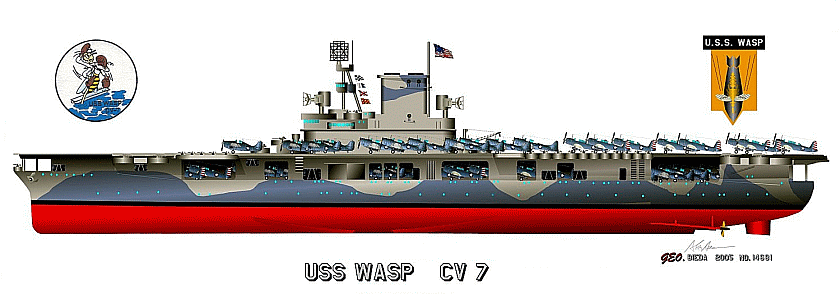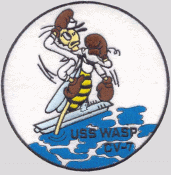Click on Thumbnail
for Full Size Image |
Size |
Image Description |
Source |
Name
|
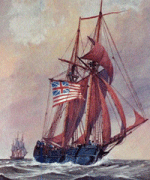
NS098680001 |
28k |
CV-7 was named to commemorate the service of seven American warships that
had borne the mame:
- A Continental Navy schooner.
- A sloop-of-war.
- A schooner.
- A sloop.
- A sloop-of-war.
- A side-wheel gunboat.
- An armed yacht.
NS098680001: The first Wasp under sail. Note the Grand Union Flag.
(Image submitted by Robert Hurst.)
NS020740: A wasp is any insect of the order Hymenoptera and suborder Apocrita
that is neither a bee nor an ant. Wasps often administer painful stings. (Vespula germanica,
photo by Richard Bartz.) |
NavSource |

NS020740 |
117k |
Construction
|

NS020748 |
773k |
The future USS Wasp on the ways, under construction. The large holes in
the Focsle Deck are for the support columns for the flight deck over, and the large hole in the center
is the Windlass Room. The date is 5 October 1938, as stated by NARA.
National Archives and Records Administration
(NARA), # 19-LC-22808. |
Darren Large |

NS020722 |
142k |
"Navy's Newest Stinger."
"Rapidly nearing completion the Navy's newest aircraft carrier, Wasp will be launched
April 4 [1939] at the Fore River plant of the Bethlehem Shipbuilding Corp., Quincy, Mass. The $20,000,000
vessel is 739 feet long and has a 110-foot beam, the largest ever built at the Fore River yard."
Associated Press photo. Bx list wf neg ny. hbr 3/31/39-7pes-pub. |
AP photo from the collection of Micheal Strout, via Jonathan Eno |

NS020737 |
143k |
"Quincy, Massachusetts—Charles Edison, Assistant Secretary of the Navy, and Mrs.
Edison are seen together at the launching of the new aircraft carrier Wasp on 4 April
1939. Mrs. Edison christened the new ship as she smashed a bottle of champagne over its prow during
her launching. Tragedy also attended this ceremony when two aircraft from the squadron making a power
dive salute to the Wasp locked wings and plummeted to earth, killing all four crew members
just as the champagne bottle struck the prow. Image courtesy of Acme Newspictures." |
Bill Gonyo |

NS020737a |
171k |
Christening by Mrs. Charles Edison (née Carolyn Hawkins), wife of the
Assistant Secretary of the Navy. |
S. Dale Hargrave |

NS020737b |
118k |

NS020737c |
267k |
Launching the future USS Wasp (CV-7), 4 April 1939.
WideWorld Photos. Back of the photo is stamped in Paris, France, 27 October 1942, after the sinking
of the ship. |
David Wright |

NS020735 |
122k |
USS Wasp (CV-7) departing Bethlehem Steel Corp, Quincy, Mass., on Monday,
18 December 1939, for her first builder's trial in Massachusetts Bay. (Thanks to Darren Large for the
information.)
Courtesy of the Vallejo Naval & Historical Museum. |
Darryl Baker |

NS020735a |
3.93M |
A small analysis of some photographs of Wasp leaving the Fore River shipyard,
by Darren Large. |
Darren Large |

NS020742 |
1.79M |
"QUINCY, MASS.—NEW UNITED STATES AIRPLANE CARRIER—Builders' trials began
yesterday for the new airplane carrier Wasp, shown above as she left her Fore River yard
dock to cruise off the coast for a week. In conformity with naval custom, dimensions and other specific
descriptions of the ship were not disclosed. During launching of the Wasp last April
two naval airplanes crashed in midair, killing four men, while flying over area. A.P. Wirephoto"
The Evening Star, Washington, D.C., Tuesday, December 19, 1939. |
Michael Mohl |

NS020723 |
82k |
A photo of USS Wasp (CV-7) during her builders trials, at anchor in President
Roads, between February 1940 and her commission. Note the hull scuttles, a feature not seen in later
designs, and the fuel pipe running along the outer hull plating. Several ship's boats can be made out.
There is no navy jack flying and the 1.1 inch guns have yet to be installed.
On Friday, February 13, Wasp went into Dry Dock #4, South Boston Naval Annex and had
her paravane handling rail removed.
(Thanks to Darren Large for the information.)
USN photo from Aircraft
Carriers of the U.S. Navy, by Stefan Terzibaschitsch. |
Robert Hurst |
Pre-War
|

NS020724 |
109k |
A peacetime photo of USS Wasp (CV-7), location and exact date unknown. |
Tommy Trampp |
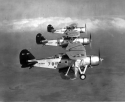
NS020761 |
1.15M |
Three Great Lakes BG-1 aircraft of Bombing Squadron (VB) 7 flying in formation near New
York City, circa 1939–1940. Pilot of 7-B-13 (# 9517) is LT Robert P. Beebe; of 7-B-15 (# 9512)
is ENS George A. Savage; of 7-B-16 (# 9520?) is ENS R.A. Parker.
National Naval Aviation Museum
(NNAM) photo, # 1996.253.1786. |
NNAM,
via Thomas Doll and William T. Larkins |

NS020730 |
92k |
Bow view of USS Wasp (CV-7) anchored at an unknown location, circa 1940.
US Navy and Marine Corps Museum/Naval Aviation Museum, photo # 2003.001.175, Chas Fischer Spring
Co. |
Mike Green |

NS020734 |
172k |
USS Wasp, port gallery walkway looking ford., from ford. .50 A. A. battery
platform, showing fly station No. 1 & deck edge elevator arm. Quincy, Mass., May 1940. |
Ed Zajkowski |

NS020734a |
214k |
USS Wasp, port side flight deck, looking ford., showing aft 5" A.A. battery,
life nets over buns, radio antenna booms. Quincy, Mass., May 1940.
(National Archives and Records Administration photo, # 19-N-22549.) |

NS020749 |
269k |
Scale pixel drawing of USS Wasp (2 pixels to 1 foot). Depicted as June
1940, showing original deck markings and light AA fit. SB2U Vindicator on the flight deck.
Drawing by Darren Large, used with permission. |
© Darren Large |

NS020731 |
484k |
SB2U-2 Vindicator with Scouting Squadron Seventy-Two (VS-72) pictured sitting on
the deck edge elevator of USS Wasp (CV-7) looking aft and down from aft end of the gun
platform. Shows elevator between decks. Picture taken at Quincy, MA. June 1940.
National Naval Aviation Museum (NNAM)
photo, # 1996.253.2139, Robert L. Lawson photograph collection. |
Curtis Tammany |

NS020731a |
126k |
SB2U-2 Vindicator with Scouting Squadron Seventy-Two (VS-72) pictured on the deck
edge elevator of the USS Wasp (CV-7) at Quincy, MA, looking to port from hangar, showing
elevator in between decks. June 1940.
US Navy and Marine Corps Museum/Naval Aviation Museum, photo # 1996.253.2132, Robert L. Lawson photograph
collection. |
Curtis Tammany |
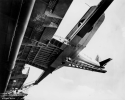
NS020731b |
384k |
SB2U-2 Vindicator with Scouting Squadron Seventy-Two (VS-72) pictured sitting on
the deck edge elevator of USS Wasp (CV-7) at flight deck level. Picture taken looking
up and aft from main deck. Picture taken at Quincy, MA. June 1940.
National Naval Aviation Museum (NNAM)
photo, # 1996.253.2140, Robert L. Lawson photograph collection. |
Curtis Tammany |

NS020731c |
294k |
SB2U-2 Vindicator with Scouting Squadron Seventy-Two (VS-72) pictured sitting on
the deck edge elevator of USS Wasp (CV-7) at flight deck level. Picture taken looking
to port from main deck. Picture taken off Quincy, MA. June 1940.
National Naval Aviation Museum (NNAM)
photo, # 1996.253.2138. |
Mike Green |

NS020731d |
385k |
USS Wasp (CV-7). Port side looking forward, from aft gun platform. Showing
boat and antenna booms. Quincy, Massachusetts, June 1940. |
Ed Zajkowski |
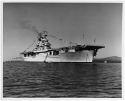
NS020711 |
398k |
Postcard showing USS Wasp anchored in Guantanamo Bay, Cuba, while "dressed"
with flags for Navy Day, 27 October 1940. Note the old flush-deck destroyer in the right distance.
Naval History and Heritage Command (NH&HC)
photo, # NH 43463. |
Richard Leonhardt |

NS020711a |
120k |
Starboard view of USS Wasp (CV-7) displaying flags on the 1940 Navy Day
Commemoration Ceremonies. Guantánamo Bay, Cuba.
National Naval Aviation Museum photo (# 2003.001.175.001). |
Mike Green |

NS020701 |
816k |
Starboard bow, 27 December 1940. National
Archives and Records Administration (NARA) photo, #80-G-463431. |
Bob Canchola, BT, USN (Ret.) |

NS020762 |
357k |
A U.S. Navy Grumman F3F-1 aircraft of
Fighting Squadron (VF) 7 (# 0262, the antepenultimate F3F-1), based aboard the aircraft carrier USS
Wasp (CV-7), 1940–1941, midway between peace and war. Note that although retaining
its peacetime colourful garb, this aircraft already has the Neutrality Patrol star added on the forward
fuselage. Not long after this photograph was taken, this aircraft received neutrality grey colouring.
USN Photo.
Scanned from United
States Navy and Marine Corps Fighters 1918–1962, compiled by Paul R. Matt and edited
by Bruce Robertson. Harleyford Publications Ltd. |
Robert Hurst |

NS020765 |
327k |
A U.S. Navy Grumman F4F-3 Wildcat
assigned to Fighting Squadron (VF) 71, USS Wasp (CV-7), on the runway at Naval Air Station
Norfolk, Virginia (USA), in 1941. Note the overall light gray paint scheme with white lettering and
numbering in effect briefly during 1941. Established as Bombing Squadron (VB) 7 on 7 July 1939, the
squadron was redesignated a fighter squadron on 1 July 1940. The squadron flew from Wasp
in support of the invasion of Guadalcanal in August 1942. Following the carrier's sinking, pilots were
landbased at Espiritu Santo, and some supplemented the defense of Guadalcanal as part of the Cactus
Air Force. VF-71 scored seven kills during World War II, and was disestablished on 7 January 1943.
National Naval Aviation Museum photo,
# 1996.229.057. |
Robert Hurst |

NS020750 |
659k |
USS Wasp (CV-7), hoisting C.R. Waterhouse aboard after being rescued, 8
March 1941. Wasp found the disabled schooner George
E. Klinck in a heavy gale off Cape Hatteras, and rescued her crew of eight.
U.S. Navy photograph, now in the collections of the National
Archives and Records Administration (NARA), # 80-G-13359. |
NARA |

NS020750 |
607k |
USS Wasp (CV-7), hoisting James Stewart aboard after being rescued, 8 March
1941 (see above).
U.S. Navy photograph, now in the collections of the National
Archives and Records Administration (NARA), # 80-G-13360. |
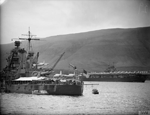
NS014295a |
503k |
USS Idaho (BB-42) and
USS Wasp (CV-7) anchored at Hvalfjord, Iceland in October 1941.
Source: Imperial War Museums, Admiralty Official Collection,
by Ware C.J. (Lt), Photo No. © IWM (A 5951). |
Mike Green |

NS020736 |
107k |
USS Wasp (CV-7) anchored at Hvalfjord, Iceland, in October 1941.
Source: Imperial War Museum Admiralty Official Collection,
by Ware C.J. (Lt), photo No. A 5959. |
Mike Green |

NS020767 |
101k |
Three U.S. Navy Vought SB2U Vindicators
from Scouting Squadron (VS) 72 off USS Wasp (CV-7) in flight over water on 4 December
1941.
National Naval Aviation Museum photo,
# 2011.003.215.029. |
Robert Hurst |

NS020766 |
206k |
Sea2c Edward Polantz preparing to release the anchor on USS Wasp (CV-7)
by striking the pelican hook with a sledge hammer, 5 December 1941.
U.S. Navy photo, now in the custody of the US
National Archives and Records Administration (NARA), College Park, Maryland, photo # 80-G-11084. |
Tracy White, Researcher @ Large |
World War 2
|
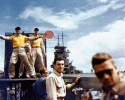
NS020713 |
447k |
LT David McCampbell, Landing
Signal Officer, bringing in planes, aboard USS Wasp (CV-7) circa late 1941 or early 1942.
McCampbell later became the Navy's top-scoring "ace" in World War II. Behind him is the Assistant Landing
Signal Officer, Ensign George E. "Doc" Savage. In the catwalk in the lower center are Len Ford (enlisted
man) and LT Hawley Russell. Caption details were provided by CAPT David McCampbell, USN (Ret.), in 1982.
Official U.S. Navy photo, now in the collection
of the National Archives and Records Administration
(NARA. Image #80-G-K-687(Color). |
Bill Gonyo
Bob Canchola, BT, USN (Ret.) |

NS020713a |
307k |
LT David McCampbell, Landing
Signal Officer, bringing in planes, aboard USS Wasp (CV-7) circa late 1941 or early 1942.
McCampbell later became the Navy's top-scoring "ace" in World War II. Behind him is the Assistant Landing
Signal Officer, Ensign George E. "Doc" Savage. In the catwalk in the lower center are Len Ford (enlisted
man) and LT Hawley Russell. Note F4F Wildcats in background, overhead. Caption details were
provided by CAPT David McCampbell, USN (Ret.), in 1982.
Official U.S. Navy photo, now in the collection
of the National Archives and Records Administration
(NARA. Image #80-G-K-688(Color). |
Bob Canchola, BT, USN (Ret.)
NARA,
via Michael Mohl |

NS020712 |
92k |
USS Wasp (CV-7) off the Norfolk Navy Yard, Portsmouth, Virginia, on 8 January
1942, following overhaul.
Photograph from the Bureau of Ships Collection in the U.S. National Archives (# 19-N-27320). |
Michael Mohl |

NS020712a |
980k |
USS Wasp (CV-7) is shown emerging from Norfolk Navy Yard on 8 January 1942,
after refit, little changed except for her search radar forward. U.S.
Navy photo.
From U.S.
Aircraft Carriers: An Illustrated Design History, by Norman Friedman. |
Robert Hurst |

NS020714 |
178k |
Two more photos also taken at the Norfolk Navy Yard, Portsmouth, Virginia,
after Wasp's December 1941–January 1942 overhaul. She retained her quadruple 1.1"/75
battery (photo NS020714) but most of her 0.50 machine guns were replaced by 20-mm
guns and she received a CXAM-1 air-search radar (photo NS020714a). |
David Buell |

NS020714a |
117k |
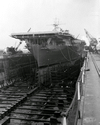
NS020747 |
198k |
USS Wasp (CV-7) in dry dock, in early 1942, at the Norfolk Nay Yard. Wasp,
in company with the aircraft escort vessel USS Long
Island (AVG-1), and escorted by USS Stack
(DD-406) and USS Sterett (DD-407),
had left the Caribbean on 22 December 1941. Two days later, the carrier moored at the Norfolk Navy
Yard to commence an overhaul that would last into 1942.
Naval History & Heritage Command (NH&HC)
photo, # NH 51105. |
Mike Green |

NS020733 |
77k |
Starboard side view and deck plan of USS Wasp (CV-7), January 1942. She
is armed with eight 5"/38 guns, four quad 1.1", thirty-four 20mm, and nine 0.50"-cal guns. Note her
forward arresting wires and two windbreaks (folded down). Provision was made for a LSO to control
over-the-bow landings (small starboard platform forward). Note CXAM-1 radar situated on the mast platform.
Drawing and text from U.S.
Aircraft Carriers: An Illustrated Design History, by Norman Friedman. |
Robert Hurst |

NS020703 |
732k |
Underway in the Atlantic, sometime in March 1942. Note that the hangar catapult outrigger,
barely visible in this photo, is folded down. |
Robert Hurst |

NS020752a |
53k |
The crew of HMS Edinburgh
(16) greets USS Wasp (CV-7) as they meet in the mid-Atlantic. The American Task Force
joined the Home Fleet in April 1942 for joint operations in the North Atlantic.
Imperial War Museums Admiralty Official Collection,
Photo No. © IWM (A 9231). |
Mike Green |

NS020752 |
60k |
The crew of HMS Edinburgh
(16) line the rails as the British light cruiser and the US carrier USS Wasp (CV-7) pass
each other in the mid-Atlantic. The American Task Force was meeting the Home Fleet in April 1942 for
joint operations in the North Atlantic.
Imperial War Museums Admiralty Official Collection,
Photo No. © IWM (A 9232). |
Mike Green |

NS020751 |
46k |
USS Wasp (CV-7) anchored at Scapa Flow in May 1942.
Imperial War Museums, Admiralty Official Collection,
by Pamall , C.H. (Lt), Photo No. A 9489. |
Mike Green |

NS020754 |
54k |
USS Wasp (CV-7) anchored at Scapa Flow Anchorage in May 1942, as seen from
HMS Illustrious (87).
HMS Rodney (29) is
anchored in the background.
Imperial War Museums, Admiralty Official Collection,
Photo No. © A 9483. |
Mike Green |

NS020706a |
755k |
Official U.S. Navy Photograph, now in the collections of the National
Archives and Records Administration (NARA), photo # 80-G-K-451.
Official caption reads: "USS Wasp (CV-7) anchored at Scapa Flow about June 1942.
Note: Battleships North Carolina
(BB-55) and Washington (BB-56) in
upper right."
Date and location of this photo and the two below, however, are wrong:
Rick E. Davis correctly states:
"Wasp, North Carolina, Washington, and an unidentified destroyer
are seen at anchor in Casco Bay, ME, on 25 March 1942."
"From the Deck Logs for Wasp, North Carolina and Washington, Wasp
and Washington operated together often in early 1942, however these two were never at the same
location with North Carolina except in March 1942 at Casco Bay, ME. Wasp arrived
at Casco Bay late on 24 March 1942 with her cruiser and destroyer escorts. She departed with Washington
and the other ships that made up TF 39 headed for the UK to be part of the Home Fleet early on 26 March
1942. So the only day that these photos could have been taken was on 25 March 1942."
|
Rick E. Davis |

NS020706 |
285k |
Official U.S. Navy Photograph, now in the collections of the National
Archives and Records Administration (NARA), photo # 80-G-K-447.
Official caption reads: "USS Wasp (CV-7) in port in June 1942, with a motor launch
coming alongside. Probably taken in San Diego Harbor, California. Planes on deck, some with wings
folded, include SB2U scout bombers and F4F-4 fighters."
Date and location, however, are wrong. The photo was taken in Casco Bay, ME, on 25 March 1942,
see above.
Tracy White (Researcher @ Large) agrees
that the official caption is wrong and adds: "The 40-mm gun tub installed during
the May–June 1942 refit does not show in this photo." |
Scott Dyben
Rick E. Davis |
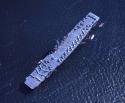
NS020706b |
2.13M |
This photo was taken at the same time as the two above, and its
official caption is also wrong.
National Archives and Records Administration
(NARA) photo, # 80-G-K-448. |
Robert Hurst
Bob Canchola, BT, USN (Ret.) |

NS020753 |
315k |
USS Wasp (CV-7) in Casco Bay, Maine, circa early 1942, with SB2U and F4F
aircraft on her flight deck. Wasp is painted in a Measure 12 (Modified) camouflage pattern.
Courtesy of the Aviation History Office (OP05D2), 1980.
U.S. Naval History and Heritage Command
(NH&HC) Photograph, # NH 91119. |
Bob Canchola, BT, USN (Ret.) |
Reinforcement of Malta, April & May 1942
|

NS020715a |
53k |
A Spitfire Mk.Vc being loaded aboard USS Wasp (CV-7) at King George
V Dock Glasgow, Scotland, in April 1942. Wasp loaded 47 Supermarine Spitfire
Mk.V fighter planes on 13 April, before she departed the Clyde estuary on the 14th. Her screen consisted
of Force "W" of the Home Fleet—a group that included the battlecruiser HMS Renown and
antiaircraft cruisers HMS Cairo and HMS Charbydis. U.S. destroyers USS Madison
(DD-425) and USS Lang (DD-399) also
served in Wasp's screen.
(Trivia: Lang was named after John Lang, a seaman aboard the sloop-of-war Wasp during
her engagement with HMS Frolic, 18 October 1812. He was the first man to board the British
ship in the closing stage of the action.)
This photo and the one below are from a notebook
compiled and written by actor and Naval Reserve officer Douglas Fairbanks, Jr. He was charged with
writing this account (the official naval record) of this special mission (Operations Calender
and Bowery) by Rear Admiral R. C. Griffin, USN. It deals with Wasp, temporarily
detached and loaned to the British Admiralty for the purpose of helping to deliver badly needed aircraft
to Malta. Fairbanks served on active duty in the US Navy from April 1941 to February 1946.
National Naval Aviation Museum photo. |
Mike Green |

NS020715 |
122k |
A Spitfire Mk.Vc being loaded aboard USS Wasp (CV-7) at Port Glasgow
[sic], Scotland, in April 1942, at the start of Operation Calender. Note some F4F Wildcat
fighters parked on deck, with their wings folded—Wasp carried twelve Wildcats
during the two aircraft ferrying missions she carried out with the Royal Navy to augment the dwindling
defenses of Malta (Operation Calender, in April, and Operation Bowery, in May 1942).
However, Charles Mac Kay correctly notes: "The Wasp did not collect the Spitfires from
Port Glasgow. They were collected from King George V Dock Glasgow; Port Glasgow is further down the
coast. The King George V Dock is beside Renfrew Airport. The Spitfires were taken from Renfrew
to the Carrier Wasp at KGV."
Note, as well, that the scrapbook where this photo comes from (see photo
above) states that the planes were actually being unloaded at that moment. National
Naval Aviation Museum photo. |
Robert Hurst
Mike Green |

NS020764 |
1.20M |
U.S. Navy Grumman F4F-4 Wildcats
from Fighting Squadron (VF) 71 and Royal Air Force
Supermarine Spitfires Mk.Vc of No. 603 Squadron RAF on the deck of the aircraft carrier USS
Wasp (CV-7), 19 April 1942. Having landed her torpedo planes and dive bombers at Hatson
in Orkney (UK), Wasp had loaded 47 Spitfires of No. 603 Squadron at Glasgow on
13 April, then departed on the 14th for Operation Calendar. Wasp and her consorts
passed through the Straits of Gibraltar under cover of the pre-dawn darkness on 19 April. At 0400 on
20 April, Wasp spotted 11 Wildcats on her deck and launched them to form a Combat
Air Patrol. Meanwhile, the Spitfires were warming up their engines and later launched for Malta.
When the launch was complete, Wasp retired toward Gibraltar.
National Naval Aviation Museum
photo, # 1996.253.7386.029. |
John Spivey |

NS0404502 |
106k |
USS Wichita
(CA-45) at anchor in Scapa Flow in April 1942. USS Wasp (CV-7) is in the background.
Official U.S. Navy Photograph, from the collections
of the Naval History and Heritage Command
(NH&HC), #NH 97884. |
NH&HC
Fred Weiss |

NS020744 |
771k |
Royal Air Force Supermarine Spitfire Mk VC is spotted on the hangar of USS Wasp
(CV-7) to be lifted to the flight deck of the aircraft carrier, 3 May 1942.
US Navy photograph, now in the collections of the National Archives
and Records Administration (NARA), # 80-G-7067. |
NARA |

NS020716 |
74k |
A Spitfire Mk.Vc about to start its take-off run. The aircraft that had taken
off ahead of it is visible above its starboard wing. Already the lift is on its way down to the hangar
to pick up the next fighter.
USN photo, taken from "Skies
of Fire," by Alfred Price. |
Robert Hurst |

NS020727 |
309k |
A British Royal Air Force Spitfire V fighter takes off from USS Wasp
(CV-7), after a 200-foot run, May 1942. Probably taken during the carrier's second Malta aircraft
ferry mission.
Official U.S. Navy Photograph, now in the collections of the National Archives (# 80-G-7083). |
Robert Hurst |
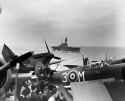
NS020728 |
600k |
Supermarine Spitfire Mk.VC's spotted on the deck of the U.S. aircraft carrier
USS Wasp (CV-7) in 1942. Wasp loaded the Royal Air Force Spitfires
on 3 May 1942 and ferried them to the Mediterranean Sea. Here they were launched on 9 May 1942 to
reinforce the British-held Malta (Operation Bovery). A Grumman F4F-4 Wildcat of Fighter
Squadron VF-71 is parked on the left with wings folded. The British carrier HMS Eagle (94)
is visible in the background. Both carriers launched 64 Spitfires.
USN photo now in the collections of the National Archives and Records
Administration (NARA), photo # 80-G-7078. |
Robert Hurst
NARA |
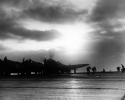
NS020745 |
572k |
Royal Air Force Supermarine Spitfire Mk VC are spotted on the flight deck of USS
Wasp (CV-7), May 1942.
USN photo now in the collections of the National Archives and Records
Administration (NARA), photo # 80-G-7084. |
NARA |
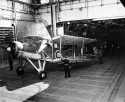
NS020746 |
816k |
Royal Air Force Swordfish aircraft up No.2 elevator of USS Wasp,
May 1942.
USN photo now in the collections of the National Archives and Records
Administration (NARA), photo # 80-G-7097. |
NARA |

NS020717 |
45k |
Official caption from the rear of the photo:
"Neg No. OCR-11886 — U.S. Navy's aircraft carrier Wasp ferries British aircraft
to Malta. First photographs showing the carrier en route to the British Mediterranean Stronghold."
"(a) Signalman on the bridge of the Wasp on the alert for any signals from escort
ships of approaching enemy ships or planes."
Photo source: NARA San Francisco. (Photo is dated 3 July 1942, which is obviously wrong, since
Wasp ferried aircraft to Malta in April and May, and was already in the Pacific by July.
This may be the date the photo was developed, or reprinted, or whatever). |
Tracy White, Researcher @ Large |

NS020718 |
31k |
Official caption from the rear of the photo:
"Neg No. OOR-11890 — U.S. Navy's aircraft carrier Wasp ferries British aircraft
to Malta. First photographs showing the carrier en route to the British Mediterranean Stronghold."
"(a) Comdr. Dickey, Executive Officer, Flight Lieut. Sly, RAF, and Lieut Sims, RAF, Engineer Officer
interview Pilot Officer [J].A. Smith, RAF, and examine his Spitfire after he made a successful
landing aboard the USS Wasp. Pilot Smith, shortly after his take-off, developed engine
trouble and signaled he was returning for a landing. Although the Spitfire has no arresting
gear, Pilot Smith managed to land the high speed fighter on the deck of the carrier without mishap—a
remarkable feat of flying and coordination with the ship."
[According to DANFS entry for Wasp, Smith accidentally released his drop tank and
lacked the range to make it to Malta. However, this is not correct—see below.]
Photo source: NARA San Francisco. (Photo is dated 3 July 1942, which is obviously wrong, since
Wasp ferried aircraft to Malta in April and May, and was already in the Pacific by July.
This may be the date the photo was developed, or reprinted, or whatever).
Corrections: Wendy Noble, sister of Canadian P/O J.A. Smith, RCAF/RAF, notes:
(1) "The correct initials for my brother are J. A.. not S. A (Jerrold Alpine Smith)."
["S.A." is actually what is written on the back of the photo.]
(2) "As stated in both his RCAF and RAF Log Books, and his diary, Jerry's long
range fuel tank was u/s. (It failed to draw). [Captain] Reeves gave permission for Jerry to
land back on the carrier and the tank would have been jettisoned in preparation for landing.
(Jerry did NOT 'develop engine trouble' and he did NOT 'accidentally release' his drop tank)."
(3) "The date of his landing was May 9, 1942 — Operation Bowery aboard USS Wasp
(CV-7). Jerry was unofficially awarded the US Navy wings on board the Wasp by Commander
Kernodle. His landing was called 'A Feat Unparalleled' by Sir Hugh Lloyd, former Air Commander-in-Chief
at Malta."
(4) "Jerry wanted to continue on to Malta after the faulty tank was replaced but permission was
denied and he returned to Gibraltar the following morning in his Spitfire as the Wasp
was going directly to the Atlantic."
(5) "Jerry flew to Malta from HMS Eagle
on May 18, 1942. On July 15 he was joined by his brother, then Flt. Lt. Roderick I. A. Smith who became
his No. 2 in 126 Squadron until Jerry was killed in action on August 10, 1942."
Additionally, Wendy explains:
"My name is Wendy Noble and Jerry was my eldest brother. He and his younger brother Rod (Sq/L Roderick
Illingworth Alpine Smith, DFC & Bar) briefly flew as a pair in Malta, having landed there at different
times, until Jerry went missing on August 10, 1942. Rod ended the war an Ace with a score of 13 1/5
shot down, the latter being the sharing of the first Commonwealth downing of an ME 262 German jet fighter.
Jerry was born on March 26, 1921, and Rod on March 11, 1922 so they were just short of a year apart
in age."
"Sources:"
"1. My source for the [second] point is my brother Rod whom I noticed crossed out a reference in
a book he owned, written by another author, which erroneously reported that Jerry's auxiliary tank
had 'fallen off.' Rod had penned in 'Failed to draw.' It's a mistake many writers make. After the
war Rod graduated from mechanical engineering and then became a lawyer, meticulous about accuracy!"
"2. I have both Rod's and Jerry's log books and was able to easily nail down the date of the landing
which was under question beside your photo."
"I have a variety (about 5) of official photos taken that day, and photos and negatives of the landing
at different stages, including one of signalman [LSO] David McCampbell giving his hat to Jerry when
he said 'My hat's off to you' by way of congratulating him on the landing. I also have letters from
the officers written to my parents. You may know that Douglas Fairbanks Jr. was aboard the Wasp
that day and wrote several pages about the landing in his memoirs."
"About 20 years ago Rod went to the States, bearing photos of the landing day, and met with the
remarkable David McCampbell who autographed them. Needless to say, I treasure those photographs."
"Rod's unfinished memoirs were taken on by British historian and Aviation writer, Christopher Shores,
for Grub Street Publishing, London. Chris added to Rod's considerable body of work where needed, and
it was published under the title, The
Spitfire Smiths: A Unique Story of Brothers in Arms."
Report on Operation Oppidan, 10 May 1942 and transcription,
for easier reading.
(Thanks to Wendy Noble and Tracy White for the corrections. We also wish to express our appreciation
to Mr. Arthur Nicholson, San Antonio, TX, who found the RAF report on Operation
Oppidan/Bowery when he was researching in the UK at the RAF archives at Kew, and
sent it to Wendy.)
NS020718a: Saturday, 9 May 1942: P/O J.A. Smith successfully
landing his Spitfire on the deck of the American aircraft carrier USS Wasp (CV-7)
due to a faulty long range fuel tank. Upon discovering his fuel feed problem, with CAPT Reeves's permission
P.O. Smith chose to land back on the carrier rather than ditching or landing in enemy territory. LSO,
LT David McCampbell, is approaching Jerry's Spitfire on the right.
NS020718b: Saturday, 9 May 1942: P.O Jerrold Alpine Smith
standing beside his Spitfire after successfully landing back on the deck of USS Wasp
(CV-7) without benefit of arresting gear. His landing was hailed as "A Feat Unparalleled" by Sir Hugh
Lloyd, former Air-Commander-in-Chief, Malta. P.O. Smith requested permission to carry on to Malta with
a new tank but in spite of Jerry being declared "cool as a cucumber" by Navy doctors, CAPT Reeves denied
permission and Jerry flew to Gibraltar the following morning. On 18 May he flew to Malta from HMS Eagle,
landing at Luqa aerodrome in the middle of a raid.
NS020718c: LT David McCampbell, LSO of Wasp,
literally takes off his hat to Pilot Officer Smith for successfully landing his Spitfire aboard
the carrier without arresting gear. At an informal ceremony later P.O. Smith was "awarded" a pair of
US Navy wings. The little party that night featured a special cake, band music, and the presentation
by actor Douglas Fairbanks
Jr. and Commander Kernoble, Air Officer, of the Navy wings to young Smith (age 22). Fairbanks wrote
an account of Jerry's landing in his memoir A
Hell of a War.
NS020718d: In February 1991 Jerry's brother, W/C Roderick
I. A. Smith, DFC+Bar, went to the US to meet CAPT David
McCampbell. By then the most decorated and highest scoring pilot of WW2, David signed three photos
for Rod in memory of 9 May 1942, the day he guided Jerry's Spitfire onto the deck of USS Wasp;
two of the pictures (NS020718c and NS020718d) are shown
here. David became the "Ace of Aces," retired in 1964, died in 1996 and is buried in Arlington Cemetery.
W/C Smith died in 2002, shortly before finishing his WW2 memoirs.
NS020718e: Saturday, 9 May 1942: LT David McCampbell demonstrating
signaling to USS Wasp pilots and crew. On 18 May 1942, P.O. Smith flew to Malta from HMS Eagle.
On 15 July his brother, Flt. Lt. Roderick I. A. "Rod" Smith, joined him on Malta and became Jerry's
Number 2 in 126 Squadron, Luqa, until Jerry was killed in action on 10 August. Many years later, in
Rod's WW2 papers, his sister Wendy found a copy of a letter written by Rod to UK author Christopher
Shores dated 19 September 1987, in which Rod relates Jerry's description of the effect that the fault
in Jerry's long range fuel tank had on its performance.
NS020718f: As stated in the document, no fewer than 23 tanks
were faulty on Operation Bowery. In 2016 Arthur Nicholson kindly introduced Jerry's sister Wendy
to USN Commander Jim Forrester, then 96, at a Stinger Club reunion in Chattanooga. Then three days
before US Brigadier General Ron Van Stockum became one hundred years old, Wendy Noble "met him on the
internet," also thanks to Arthur Nicolson! Both men were present on USS Wasp on 9 May
1942, and saw Jerry's landing.
NS020718h & NS020718h1: Pages from Jerrold Alpine Smith's log book.
NS020718i: Letter to Mrs. Smith from Captain Witherspoon, ChC, USN, dated
8 September 1943.
NS020718j: Letter from W.A. Graham, CPhM, U.S. Navy, U.S. Naval Hospital,
Memphis, Tennessee, to Mrs. Smith, mother of Jerry Smith, 27 September 1943.
NS020718k: Letter from CAPT Bartholomew W. Hogan, Medical Corps,
U.S. Navy, to W.A. Graham, CPhM, U.S. Navy, U.S. Naval Hospital, Memphis, Tennessee, 23 September 1943.
Then CDR Hogan had been the senior Medical Officer aboard Wasp. |
Tracy White, Researcher @ Large |

NS020718a |
41k |
Wendy Noble |

NS020718b |
44k |

NS020718c |
47k |

NS020718d |
58k |

NS020718e |
218k |

NS020718f |
1.79M |
Wendy Noble |

NS020718g |
136k |

NS020718h |
403k |

NS020718h1 |
311k |

NS020718i |
9.44M |

NS020718k |
1.13M |
Wendy Noble |

NS020718j |
441k |

NS020738 |
160k |
USS Wasp (CV-7), April 1942. Royal Navy Swordfish aircraft entering landing circles across bow, starboard to port, just prior to landing aboard,
somewhere in the Atlantic.
U.S. Navy photograph, now in the collections of the National Archives (# 80-G-7101). |
National Archives and Records Administration (NARA) |

NS020738a |
153k |
USS Wasp (CV-7), April 1942. Royal Navy Swordfish aircraft in groove
ready to land aboard, somewhere in the Atlantic.
U.S. Navy photograph, now in the collections of the National Archives (# 80-G-7104). |
National Archives and Records Administration (NARA) |

NS020738b |
178k |
USS Wasp (CV-7), April 1942. Royal Navy Swordfish aircraft with
wings folded ready to be sent to hangar deck, somewhere in the Atlantic.
U.S. Navy photograph, now in the collections of the National Archives (# 80-G-7106). |
National Archives and Records Administration (NARA) |

NS020738c |
181k |
USS Wasp (CV-7), April 1942. Royal Navy Swordfish aircraft with
wings folded on the No.3 elevator, somewhere in the Atlantic.
U.S. Navy photograph, now in the collections of the National Archives (# 80-G-7113). |
National Archives and Records Administration (NARA) |

NS020726 |
79k |
Rear Admiral Robert C. Giffen, USN (left), Commander, Task Force 99, visits with a British
Vice Admiral on board HMS Duke of York,
probably at Scapa Flow. Photo is dated 22 April 1942. USS Wasp (CV-7) is in the right
background.
Official U.S. Navy Photograph, now in the collections of the National Archives (# 80-G-21027). |
Naval History & Heritage Command |

NS020726a |
75k |
Rear Admiral Robert C. Giffen, USN, in command of the American Task Force,
right, with Vice Admiral Sir Alban T.B. Curteis when he visited HMS Duke
of York (17) at the Scapa Flow anchorage in April 1942. USS Wasp (CV-7) is in
the background.
Imperial War Museums, Admiralty Official Collection, Coote
R.G.G.. (Lt) photographer, Photo No. © IWM (A 9228). |
Mike Green |
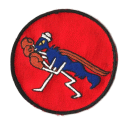
NS020739 |
45k |
"The Fighting Wasps" was established as VF-7 on 1 July 1939 and redesignated
VF-72 on 19 November 1940. After a brief stint aboard USS Ranger (CV-4),
December 1941–March 1942, VF-72 rode Wasp again, for her first Mediterranean trip
to reinforce Malta in April 1942. Then Wasp and her aircraft shifted to the Pacific.
When Wasp was sunk in Septermber 1942, VF-72 was assigned to relieve the shattered VF-8
aboard USS Hornet (CV-8). After Hornet, in turn, was sunk in October,
some veterans from the squadron joined VF-10 aboard USS Enterprise (CV-6);
others spread their experience throughout CVE squadrons in the Solomons. Subsequently land-based,
VF-72 was disestablished on 29 March 1943. |
Tommy Trampp |
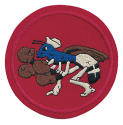
NS020739a |
266k |
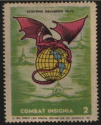
NS020758 |
37k |
Scouting Squadron (VS) 72 "Centaur Vampires" was established on 1 July 1939. One of the
largest non-VB squadrons to use the SB2U Vindicator, it embarked aboard USS Wasp
(CV-7) in April 1940. In June 1942 the squadron traded its SB2U-2s for SBD-3 Dauntlesses, in
time to participate in the Guadalcanal campaign. VS-72 was disestablished on 4 January 1943.
This is a Disney-designed Combat Insignia stamp. |
Tommy Trampp |
|

NS020755 |
44k |
Being watched by ratings on HMS Illustrious
(87), USS Wasp (CV-7) comes to anchor at Scapa Flow Anchorage in May 1942.
Imperial War Museums, Admiralty Official Collection,
Photo No. © IWM (A 9471). |
Mike Green |

NS020743 |
210k |
A Fleet Air Arm Gloster Sea Gladiator, piloted by Captain Henry Lockhart St. John
Fancourt, lands on the aircraft carrier USS Wasp (CV-7), at Scapa Flow, May 1942. This
was the first landing of the war by a British [carrier] plane on an American aircraft carrier.
Captain Fancourt was CO of HMS Sparrowhawk (Naval Air Station Halston) on the island of Mainland,
Orkney, Scotland. Courtesy Orkney Public Library and the Gregor Lamb Collection.
Image scanned from Scapa:
Britain's Famous Wartime Naval Base, by James Miller. |
Robert Hurst |

NS020702 |
432k |
USS Wasp (CV-7) entering Hampton Roads, Virginia, on 26 May 1942. Destroyer
USS Gleaves (DD-423) is in the background.
Official U.S. Navy Photograph, now in the collections of the National
Archives and Records Administration (NARA), photo # 80-G-12240. |
Bob Canchola, BT, USN (Ret.) |

NS020704 |
50k |
Undated, starboard side view, Underway. (Atlantic). |
USN |

NS020720 |
108k |
USS Wasp (CV-7), starboard bow, Norfolk Navy Yard, Portsmouth, Va., 3 June
1942. Photo serial 3169(42). |
David Buell |

NS020720a |
105k |
USS Wasp (CV-7), starboard quarter, Norfolk Navy Yard, Portsmouth, Va.,
3 June 1942. Photo serial 3170(42). |

NS020720b |
52k |
"U.S.S. Wasp, new [40-mm] gun platform, port side near stern." Norfolk
Navy Yard, Portsmouth, Va., 3 June 1942. Photo serial 3171(42).
Source: San Francisco NARA, "Pearl Harbor Navy Yard General Correspondence Files, 1941-45." |
Tracy White, Researcher @ Large |

NS020729 |
56k |
USS Wasp (CV-7).
James comments: "This is the best picture of the 40mm mounting I have seen
that shows the mount from above." |
James P. Laurora |
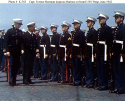
NS020760 |
380k |
Captain Forrest P. Sherman
inspecting the US Marine Corps detachment aboard carrier USS Wasp (CV-7), San Diego,
California, United States, late June 1942.
National Archives and Records Administration
(NARA) photo, # 80-G-K-763.
Walking next to CAPT Sherman is Captain of the Marine Detachment, Capt. John
W. Kennedy, Jr., who went down with the ship on 15 September 1942. (Thanks to Darren
Large for the info.) |
Courtesy of Scott Koen & ussnewyork.com |

NS020763 |
423k |
Personnel inspection aboard USS Wasp (CV-7) on the forward flight deck,
at Naval Air Station North Island, San Diego, California, in June 1942.
National Archives and Records Administration
(NARA) photo, # 80-G-K-768. |
NARA,
via Michael Mohl |

NS020708 |
41k |
Wartime photo. Date and place unknown. |
Submitted by Clint Wingrove from the collection of his grandfather Joseph
L. Wingrove. BM/2c. USN, USS Phoenix CL-46, 1939-45 |

NS020732 |
135k |
King Neptune and his party stride down the flight deck of USS Wasp (CV-7)
after "arriving" on board for Equator crossing ceremonies, circa July 1942.
Official U.S. Navy Photograph, now in the collections of the National Archives (# 80-G-K-811).
Note: The correct date for this photo is probably 8 July 1942, as there are Shellback Certificates
issued on said date (thanks to Curtis Tammany for pointing this out). |
Tommy Trampp |

NS020732a |
191k |
"Neptune party on USS Wasp (CV-7)." Photo dated 11 July 1942 (but see
Note above.)
Photo No. WASP #1089. Bureau of Aeronautics photo, now in the collections of the National
Archives and Records Administration (NARA), # 80-G-64895. |
Tracy White, Researcher @ Large |
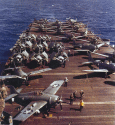
NS020725 |
443k |
Grumman F4F-4 Wildcat fighters and Douglas SBD Dauntless dive bombers aboard
USS Wasp (CV-7), probably in July–September 1942. |
Robert Hurst
Scott Koen & ussnewyork.com |

NS020757 |
340k |
SBD-3 Dauntlesses, part of Scouting Squadron Seventy One/Seventy Two (VS-71/72,)
are seen aboard USS Wasp (CV-7), along with F4F-4 Wildcats of Fighter Squadron
Seventy One (VF-71). The photo is undated, but the ship is conducting operations in the vicinity of
Guadalcanal in support of the 7 August 1942 landings. Eleven VS-71 planes and crews were transferred
to Guadalcanal after Wasp was sunk on 15 September. They flew combat missions from Henderson
Field until 7 November.
National Naval Aviation Museum (NNAM)
photo, # 1996.253.731. |
Mike Green |

NS020721 |
134k |
Scene on the carrier's port bridge wing, during operations off Guadalcanal on 7 August
1942.
Among those present are (from left to right, in the right center) Commander D.F. Smith (hatless);
Captain Forrest P. Sherman, Commanding Officer (wearing helmet); Rear Admiral Leigh Noyes, Commander
Task Group 61.1 (facing camera); and Lieutenant Commander Wallace M. Beakley, Commander Wasp
Air Group, who is making his report to RADM Noyes.
Note SBD-3 Dauntless scout bombers (one with a rather small National star painted on its
fuselage) on the flight deck and .30 caliber machine gun mounted on the bridge bulwark.
Official U.S. Navy Photograph, now in the collections of the National Archives (# 80-G-16864). |
Gerd Matthes, Germany |

NS020721b |
172k |
Guadalcanal-Tulagi Operation, August 1942. Grumman F4F-4 Wildcat fighters prepare
to take off from USS Wasp (CV-7) on 7 August 1942, the first day of landings on Guadalcanal
and Tulagi.
Official U.S. Navy Photograph, now in the collections of the National
Archives, # 80-G-14053. |
Courtesy of Scott Koen & ussnewyork.com |

NS020721a |
101k |
Grumman F4F-4 Wildcat fighters of Fighting Squadron (VF) 71 launching from the
aircraft carrier USS Wasp (CV-7), 7 August 1942. U.S. Navy photo. |
Robert Hurst |

NS020705 |
327k |
USS Wasp (CV-7) burning and listing after she was torpedoed
by the Japanese submarine I-19,
on 15 September 1942, while operating in the Southwestern Pacific in support of forces on Guadalcanal.
NS020705: Official U.S. Navy Photograph, now in the collections of the National
Archives and Records Administration photo, # 80-G-16331.
NS020705b: US Navy photo.
NS020705c: US Navy photo. |
Gerd Matthes, Germany
Bob Canchola, BT, USN (Ret.) |
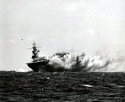
NS020705b |
121k |
Mike Green |

NS020705c |
138k |
Courtesy of Scott Koen & ussnewyork.com |

NS020705a |
546k |
USS Wasp (CV-7) burning after receiving two torpedo hits from the Japanese
submarine I-19 while steaming
well to the southward of Guadalcanal, 15 September 1942. Photo probably taken from USS San
Francisco (CA-38).
Official U.S. Navy Photograph. Available from the Library
of Congress Prints and Photographs Division, Reproduction Number LC-USW33-017656-ZC. |
Curtis Tammany |

NS020710 |
172k |
USS O'Brien (DD-415)
is torpedoed by Japanese submarine I-19
during the Guadalcanal Campaign, 15 September 1942. USS Wasp (CV-7), torpedoed a few minutes
earlier, is burning in the left distance. O'Brien was hit in the extreme bow, but "whipping"
from the torpedo explosion caused serious damage to her hull amidships, leading to her loss on 19 October
1942, while she was en route back to the United States for repairs.
Official U.S. Navy Photograph, now in the collections of the National
Archives and Records Administration photo, # 80-G-457818. |
Bob Canchola, BT, USN (Ret.) |
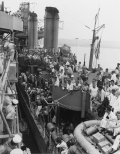
NS0545903 |
857k |
USS Laffey (DD-459)
alongside a cruiser (either USS Salt
Lake City (CA-25) or USS Pensacola
(CA-24)) with survivors of USS Wasp (CV-7) aboard, probably at Espiritu Santo, New Hebrides.
Wasp had been sunk by Japanese submarine I-19
on 15 September 1942. Note Laffey's smokestacks, searchlight, mainmast, depth charges, and fully
outfitted liferaft.
Official U.S. Navy Photograph, now in the collections of the National
Archives and Records Administration photo, # 80-G-13612. |
Robert Hurst |

NS020741 |
9.81M |
USS Wasp (CV-7), Booklet of General Plans, 8 August 1940; corrected to
suit ship, 23 September 1942. |
Courtesy of the Historic Naval Ships Association, via
Curtis Tammany |
|

NS020759 |
40k |
Wreckage from USS Wasp (CV-7) was discovered on 14 January 2019 by the
late Paul G. Allen's Research Vessel (R/V) Petrel.
This is one of Wasp's 5-inch guns. |
Courtesy of Navigea Ltd.,
via Tommy Trampp |
Models
|

NS020719 |
111k |
Model of USS Wasp (CV-7), on display at the National
Naval Aviation Museum, Pensacola, Florida. Photos taken on 13 June 2008. |
Photos by Judson Phillips |

NS020719a |
102k |

NS020719b |
132k |

NS020719c |
105k |
For more information about this ship, see:
|
